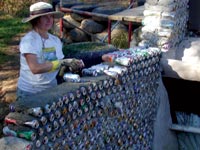Stan and Pattie Frost Jones were in the midst of constructing their Madison County earthship when Xpress first visited the site in October 2003 (see “Earthship Space: Local Couple Building Dream Home Out of Tires,” Aug. 3, 2005 Xpress). Three-and-a-half years later, the decidedly nontraditional house has surpassed the owner/builders’ expectations in multiple ways.

An earthship is designed to be self-sufficient, generating minimal environmental impact both during and after construction. Ideally, energy input is limited to daily solar gain.
The Joneses’ earthship is powered by an array of solar panels that charge a bank of batteries. And after two winters, the array appears oversized for the couple’s current needs, says Stan. (Short days make winter the critical test for any solar application.) “We could have reduced the size of the system by about a third,” he reports, which would have saved money. On the other hand, he notes, “We want to add a low-voltage refrigerator to our list of appliances at some point and intend to power our workshop from this same system” when it gets built.
“All winter,” adds Pattie, “we laundered clothes in a standard, front-load washer powered by the sun. Clothes were hung out to dry on our solar- and wind-generated dryer [clothesline]. This worked very well.”
The structure’s entire roof catches rainwater, which is stored in two huge cisterns—one for household use and one for future garden irrigation. “We’ve had more water than we can use in the household tank, and we haven’t begun to tap the irrigation tank at this point,” says Stan.
That’s not to say that there haven’t been problems. “The company that we purchased our liquid-rubber roof membrane from has been nothing but difficult to work with,” notes Pattie. “When the product did not perform as advertised, the company was so uncooperative that we filed a complaint. The roof is patched and secure now, but we are looking for a new roof-coating material.”
The whole front wall is glass, and the house faces slightly west of south to make optimum use of winter sun for passive solar heating. The earth-packed tires overlaid with stucco, the flagstone floors, and the soil mounded up against the rear wall all soak up heat when the sun shines and reradiate it at night. A small wood stove provides backup heat on cloudy days when the stored heat begins to dissipate.
“The winter of 2006-07 was particularly warm,” Pattie recalls, “but with passive-solar heat and thermal mass, the temperatures never dropped below 60 degrees. On a few consecutive, cloudy nights, we added some heat from a small wood stove to cozy up the place.”
Earthships were originally designed and built in the Southwest, where earth-sheltered housing dates back at least to the Anasazi. Using castoff vehicle tires filled with rammed earth represents a new structural approach, but the basic idea is the same.
In North Carolina’s far wetter climate, however, earth-sheltered buildings are a whole other story. One such structure at the old Mother Earth Eco-Village was plagued by leaks. The Joneses’ 2,000-square-foot home stays dry, though. Careful site selection—the home sits on a well-drained knoll—and thorough waterproofing have worked as planned, the couple reports. Water problems, notes Stan, are not intrinsic to earth-sheltered housing; they’re a function of design and construction. “Over the years, I’ve seen numerous wood-frame homes with mold problems.”
This summer, Stan is headed to Wisconsin to help a friend build a similar home. After that, he’s eager to find others who want to take green building to the next level—crafting elegant shelters out of discarded tires and aluminum cans.


Before you comment
The comments section is here to provide a platform for civil dialogue on the issues we face together as a local community. Xpress is committed to offering this platform for all voices, but when the tone of the discussion gets nasty or strays off topic, we believe many people choose not to participate. Xpress editors are determined to moderate comments to ensure a constructive interchange is maintained. All comments judged not to be in keeping with the spirit of civil discourse will be removed and repeat violators will be banned. See here for our terms of service. Thank you for being part of this effort to promote respectful discussion.